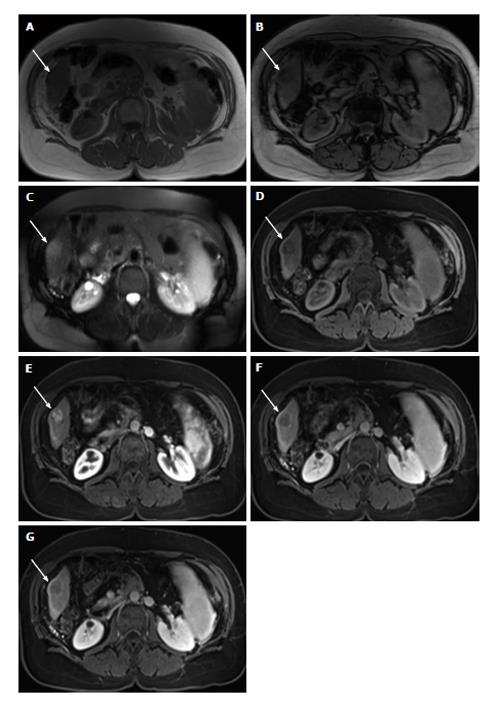Copyright
©The Author(s) 2015.
World J Hepatol. Aug 8, 2015; 7(16): 1987-2008
Published online Aug 8, 2015. doi: 10.4254/wjh.v7.i16.1987
Published online Aug 8, 2015. doi: 10.4254/wjh.v7.i16.1987
Figure 7 Hepatocellular carcinoma.
In- (A) and opposed-phase (B) GRE T1-WI, fat-suppressed FSE T2-WI (C), pre (D) and postcontrast fat-suppressed 3D-GRE T1-WI at the arterial (E), portal venous (F) and interstitial (G) phases. There is a small peripheral lesion on the right lobe of a cirrhotic liver (arrow, A-G), showing drop of signal intensity on opposed-phase (B) comparing with the in-phase (A) images, which is suggestive of fat content. The lesion demonstrates mild high signal intensity on T2-WI (C), low signal intensity on pre-contrast T1-WI (C), heterogeneous enhancement on early post-contrast (E) and subsequent washout with associated pseudocapsule on delayed post-contrast images (F and G), in keeping with a small fat-containing hepatocellular carcinoma. GRE: Gradient-echo; FSE: Fast spinecho; T1-WI: T1-weighted images.
- Citation: Matos AP, Velloni F, Ramalho M, AlObaidy M, Rajapaksha A, Semelka RC. Focal liver lesions: Practical magnetic resonance imaging approach. World J Hepatol 2015; 7(16): 1987-2008
- URL: https://www.wjgnet.com/1948-5182/full/v7/i16/1987.htm
- DOI: https://dx.doi.org/10.4254/wjh.v7.i16.1987









